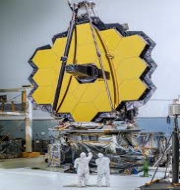Quartz Nanocrystals Detected in Exoplanet’s Clouds
Astronomers using the James Webb Space Telescope have made a remarkable discovery in the atmosphere of the exoplanet WASP-17b, located approximately 1,300 light-years away from Earth.
The Exoplanet and Its Atmosphere
- WASP-17b: This exoplanet is classified as a “hot Jupiter” and is situated far from our solar system, making it a fascinating object of study.
- Astronomical First: The recent detection marks the first time that silica particles, specifically quartz nanocrystals, have been identified in the atmosphere of an exoplanet.
The Significance of Quartz Nanocrystals
- Earthly Origin: Silica particles are common on Earth and are a major component of our planet’s mass. They are also found on other rocky bodies in our solar system.
- Unusual Find: Previous observations had indicated the presence of silicate grains in exoplanet atmospheres, but they were believed to be magnesium-rich silicates like olivine and pyroxene. Quartz, which is pure silicon dioxide, was an unexpected discovery.
Implications for Exoplanet Science
- New Insights: This discovery challenges astronomers’ understanding of how clouds form and evolve on exoplanets. Instead of the expected magnesium silicates, quartz particles appear to be the fundamental “seed particles” for creating silicate grains.
- Cloud Formation: Understanding the composition of exoplanet clouds is crucial for gaining insights into their atmospheres and climate, and this finding provides a fresh perspective on cloud formation processes.
Month: Current Affairs - October, 2023
Category: Science & Technology Current Affairs








